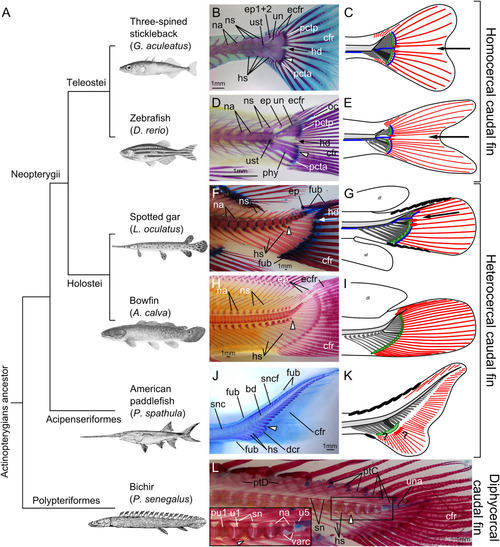FIGURE
Fig. 1
- ID
- ZDB-FIG-180806-2
- Publication
- Desvignes et al., 2018 - Evolution of caudal fin ray development and caudal fin hypural diastema complex in spotted gar, teleosts, and other neopterygian fishes
- Other Figures
- All Figure Page
- Back to All Figure Page
Fig. 1
|
Evolution of the caudal fin skeleton in actinopterygians. A: Phylogenetic relationships of actinopterygians investigated here (after Near et al., 2012, 2014; Betancur‐R et al., 2013, 2017). B,D,F,J,L: Alcian Blue and Alizarin Red cleared and stained skeletons. H: Alizarin Red cleared and stained skeleton. B,C: Adult three‐spined stickleback (Gasterosteus aculeatus), 69 mm TL. D,E: Adult zebrafish (Danio rerio), 28 mm TL. F,G: Adult spotted gar (Lepisosteus oculatus), 493 mm TL. H,I: Adult bowfin (Amia calva) 233 mm TL. J,K: Young American paddlefish (Polyodon spathula), 84 mm TL. L: Adult bichir (Polypterus senegalus), 161 mm TL. For each species, the white elongated triangle indicates hypural 1 as a reference. In B‐G, the arrow points to the hypural diastema. Scale bars = 1 mm. bd, basidorsal arcualia; cfr, caudal fin rays; dcr, distal caudal radials; ecfr, epichordal caudal fin rays; ep, epurals; ep1+2, compound epural made by the fusion of epurals 1 and 2; fub, basal fulcra; hd, hypural diastema; hs, haemal spines; oc, opisthural cartilage; na, neural arches; ns, neural spine; phy, parhypural; pcta, anterior plate of connective tissue; pctp, posterior plate of connective tissue; ptC, pterygiophores of the caudal fin; ptD, pterygiophores of the dorsal fin; pu1, preural centrum 1; sn, supraneurals; snc, supraneurals of the caudal skeleton; sncf, supraneurals of the caudal fin skeleton; un, uroneural; una, ural neural arch; ust, urostyle; u1, ural centrum 1; u5, ural centrum 5; varc, ventral arcualia. In the schematic representations of caudal fin organization (C,E,G,I,K), the notochord is represented in light gray, the haemal elements in dark gray, and the first hypural in black. Plate(s) of connective tissue are represented in green. A black arrow points at the hypural diastema in teleosts (C,E) and gar (G). Caudal vasculature is represented in blue in teleosts (C,E) and gar (G) based on literature and previously published information (Schultze and Arratia, 1986, 1988; Arratia and Schultze, 1992; Arratia, 2013, 2015; Wiley et al., 2015; Desvignes et al., 2018) as well as histological observations in zebrafish and gar (cf. Fig. 3); the vasculature is not shown for bowfin (I) and paddlefish (K) because it is unknown or inconsistently positioned. Caudal lepidotrichia are represented in red, with the earliest‐forming lepidotrichia marked with an oval at their base. Fulcra are represented with plain black ovals on the dorsal and/or ventral leading edge of the fin in gar (G) and paddlefish (K). Question marks in paddlefish (K) denote uncertainty concerning the plate of connective tissue and the earliest‐forming caudal lepidotrichia. Abbreviations: af, anal fin; df, dorsal fin.
|
Expression Data
Expression Detail
Antibody Labeling
Phenotype Data
Phenotype Detail
Acknowledgments
This image is the copyrighted work of the attributed author or publisher, and
ZFIN has permission only to display this image to its users.
Additional permissions should be obtained from the applicable author or publisher of the image.
Full text @ Dev. Dyn.

